Missy Mazzoli's New Take on Classical
By Stephen Brookes • The Washington Post • May 8, 2011
Ask composer Missy Mazzoli about the state of contemporary classical music, and you’ll get an earful. The academia-centered world of composing is “grumpy and dogmatic,” she says, an isolated, inward-looking place where composers need to write in an abstruse style if they want to be respected by their peers.
No matter that the thorny music of the last half-century has kept audiences away in droves; composers who try to reach a wider audience risk being “looked down on as stupid and uneducated,” she says, or they leave classical music entirely.
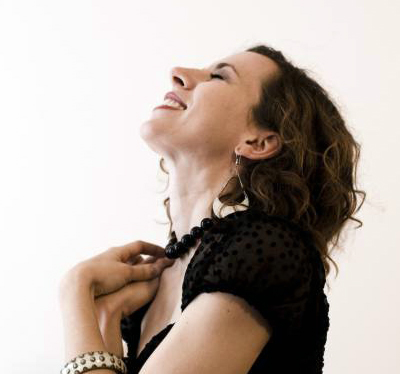 Missy Mazzoli“The word ‘accessible’ can really ruffle feathers within the new music community,” Mazzoli says, with more than a trace of exasperation. “But I don’t think that ‘accessible’ equals oversimplifying, or dumbing things down, or playing to the lowest common denominator. The goal of my music has always been to communicate with an audience. That sounds obvious to 99 percent of the world, but it really is blasphemy to say that within academia!”
Missy Mazzoli“The word ‘accessible’ can really ruffle feathers within the new music community,” Mazzoli says, with more than a trace of exasperation. “But I don’t think that ‘accessible’ equals oversimplifying, or dumbing things down, or playing to the lowest common denominator. The goal of my music has always been to communicate with an audience. That sounds obvious to 99 percent of the world, but it really is blasphemy to say that within academia!”
Academia may just have to get used to it. The Brooklyn-based Mazzoli — who will perform with her electro-acoustic quintet, Victoire, at Atlas Performing Arts Center on Saturday — is one of the fastest-rising young composers in America, and she is determined to drag contemporary music out of its prickly seclusion and into the real world.
Her music is being played everywhere from rock clubs to Carnegie Hall, and the accolades are mounting. “Cathedral City,” which she released with Victoire last September, was ranked one of the best classical CDs of 2010 by the New Yorker, NPR and the New York Times. Her work has been commissioned by a who’s who of new music groups, from the Kronos Quartet and eighth blackbird to the American Composers Orchestra. The New York Times has called her “among the more consistently inventive, surprising composers now working in New York,” and Alex Ross of the New Yorker singled her out as “a leader of New York’s young moderns.”
Not bad for a composer who just turned 30.
But Mazzoli’s unique, hard-to-precisely-nail-down music (she describes it as a “blend of dreamy post-rock, quirky minimalism and rich romanticism”) reflects a trend among New York-based composers to write music for the omnivorous audiences of the 21st century — listeners with everything from Guillaume Dufay to Tuvan throat-singing in their ears. She and Victoire play to classical audiences (they recently shared a stage with the Jack Quartet), and her orchestral works are heard in concert halls, but she’s equally at home at pop festivals or in clubs. Many of Mazzoli’s most ardent fans, in fact, come from the world of indie rock.
It’s easy to see why. Mazzoli’s music is irresistibly seductive. You sink into “Cathedral City” as if it were a river, carried along on its shifting, propulsive rhythms and ethereal harmonies. Shimmering layers of sound rise to the surface, dissipate and drift away, as others appear to take their place. Melodic currents shift tempo and direction, eddies suddenly swirl, phrases build in hypnotic repetition before turning, through some deft sleight of ear, in unexpected new directions. It’s a gorgeous and often mysterious sound-world with an indie-rock sensibility, subtle and complex (there’s even a sort of fugue in the title track) but run through with what Mazzoli calls “beautiful simplicity.” And that may be the key to its appeal.
“A lot of my music is built from very simple materials, but I try to put them together in ways that are not so simple,” she says. “I use a lot of triads, a lot of very simple intervals and repetitive melodies, but I combine them in ways that obscure the key, for example, or obscure the meter. I want people to feel, ‘Oh, this sounds familiar, I think I know where it’s going’ — then to be continually surprised.”
But — to raise the obvious question — is music so comfortable in the indie-rock world still “classical”?
“People often ask me that,” says Mazzoli, who has a master’s in composition from Yale, majored in music at Boston University and won a Fulbright scholarship to study at the Royal Conservatory of the Hague with Louis Andriessen.
“And I sometimes say, ‘Well, the “Classical” era ended in 1830, so . . . no!’ But I am coming out of the classical tradition, even if I’m going in wildly different directions. I write for classical instruments, I write for orchestras, but I’m also very much influenced by indie rock and the vernacular. That’s sort of inevitable. I’m 30 years old; I’ve grown up with the Internet and with pop music for most of my life. How could that not influence me?”
Mazzoli’s deepest musical roots — and her independent approach to composing — go back to a childhood encounter, growing up outside of Philadelphia. Her family wasn’t particularly musical, but as a 9-year-old she stumbled across Beethoven and promptly fell in love.
“We had a couple of random Beethoven cassette tapes, but they were more about the life of Beethoven than his actual music,” she says, laughing. “They’d play a little of the Sixth Symphony and then say, ‘Ludwig van Beethoven was born in 1770, and . . .’ So I would just fast-forward to all the music.” But Beethoven awoke something powerful in her — “It felt sort of unhinged and unpredictable” — and she started composing on her own, puzzling it out as she went along.
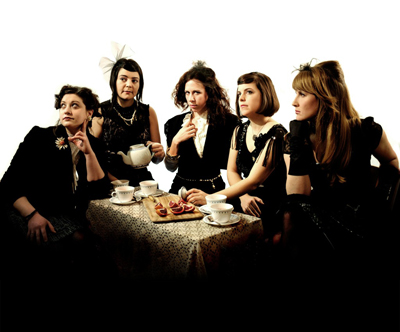 Victoire, at teaHaving to find her own way into classical music, she says now, was the best thing that could have happened to her.
Victoire, at teaHaving to find her own way into classical music, she says now, was the best thing that could have happened to her.
“There was always a healthy struggle to figure out how to write,” she says. “It was a series of small, personal victories throughout my childhood. No one was telling me to listen to anything, so I felt that every piece that I discovered was there for me alone.”
Mazzoli’s life now consists of almost constant writing and performing, largely with Victoire, which she formed in 2008 with like-minded friends. The all-female quintet (Olivia De Prato on violin, Eileen Mack on clarinet, Lorna Krier on keyboards and Eleonore Oppenheim on bass, with Mazzoli doubling on keyboards and lo-fi electronics) has become a crucial sounding board. “I can try things and fail spectacularly, but do it in the privacy of my own home,” she says. Equally importantly, she can bring her music directly to audiences, anywhere in the world.
“That’s the point of my work: I don’t want it to exist in a vacuum,” she says. “And there’s a community in New York that feels the same way.” A largely Brooklyn-based group of composers and performers — people such as William Brittelle, Nico Muhly, the NOW Ensemble (which will perform with Victoire on Saturday), Judd Greenstein, Nadia Sirota and many others — are producing music of exceptional complexity and sophistication while remaining, Mazzoli says, “unabashedly committed” to building audiences.
“We’re all creating opportunities for each other, running festivals, creating ensembles that perform each other’s music. We’re not just in it for ourselves; that’s what makes this group of composers stand out,” she says. “We’re in it for the good of the field.”
****
Missy Mazzoli and Victoire will be performing at the Atlas Performing Arts Center on a double bill with the NOW Ensemble on Saturday at 8 p.m. There will be a pre-concert presentation by Mazzoli and composer Judd Greenstein at 6:15. On May 20, the new music ensemble Eighth Blackbird will perform Mazzoli’s “Still Life With Avalanche” at the Library of Congress.
Verge Ensemble at the Corcoran Gallery of Art
By Stephen Brookes • The Washington Post • April 19, 2011
Kaija SaariahoYou knew something interesting was happening at the Corcoran Gallery of Art when clarinetist David Jones swept the music off his stand, pulled a wrinkled sheet of paper out of his pocket and began to furiously wail on his instrument. Violinist Lina Bahn, meanwhile, was reaching over Tobias Werner’s shoulder to play his cello with her bow, while Jenny Lin strummed the strings of her piano with a pearl necklace. Just a normal afternoon, in other words, in the life of the Verge Ensemble, which closed out its 2010-2011 season on Sunday with one of its typically imaginative, playful and up-to-the-minute concerts of new music.
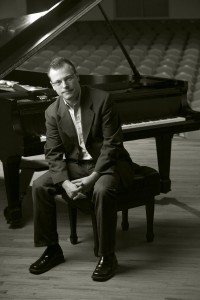 Jeffrey NytchThat particular piece — a controlled improvisation called “reaLive 2008,” by Verge artistic director Steve Antosca — may have been the most theatrical on the program, but the rest of the fare was just as engaging. Gina Biver’s “The Cellar Door” built on Jungian ideas of unifying the conscious and the unconscious minds, pitting vivid, “human” lines in the cello and piano against a track of manipulated waterphone sounds, unifying the two in a striking climax. Frederick Weck projected video of shifting, amorphous colors for his “video ix” while pianist Lin carved well-defined lines on the piano, and Timothy Beyer presented a piece that was as much poetry as it was music: an electronically manipulated reading of a dramatic text titled “I have so often dreamed of you.”
Jeffrey NytchThat particular piece — a controlled improvisation called “reaLive 2008,” by Verge artistic director Steve Antosca — may have been the most theatrical on the program, but the rest of the fare was just as engaging. Gina Biver’s “The Cellar Door” built on Jungian ideas of unifying the conscious and the unconscious minds, pitting vivid, “human” lines in the cello and piano against a track of manipulated waterphone sounds, unifying the two in a striking climax. Frederick Weck projected video of shifting, amorphous colors for his “video ix” while pianist Lin carved well-defined lines on the piano, and Timothy Beyer presented a piece that was as much poetry as it was music: an electronically manipulated reading of a dramatic text titled “I have so often dreamed of you.”
A technical glitch made it impossible to play the computer track to Kaija Saariaho’s stunning 1988 work “Petals,” but that turned out to be blessing; Tobias Werner played the piece in its original form for solo cello, revealing subtle colors and extraordinary details often lost in the more widely heard version. But the most intriguing piece on the program may have been the world premiere of Jeffrey Nytch’s “Nottorno.” A most vivid and unsettling nocturne, the piece evoked that dreamlike state between waking and sleeping, a surrealistic world where all things are possible and events take on a logic all their own.
21st Century Consort at The Museum of American Art
By Stephen Brookes • The Washington Post • April 18, 2011
 John CageThe 21st Century Consort has a symbiotic relationship with the Smithsonian American Art Museum, presenting concerts of new music there that tie in with the museum’s exhibits. The approach sometimes works better in theory than practice, and the professed links between Saturday’s program and the artist Robert Rauschenberg were, shall we say, a little diaphanous. But never mind – Consort director Christopher Kendall always manages to assemble thought-provoking programs that stand up perfectly well on their own two musical feet.
John CageThe 21st Century Consort has a symbiotic relationship with the Smithsonian American Art Museum, presenting concerts of new music there that tie in with the museum’s exhibits. The approach sometimes works better in theory than practice, and the professed links between Saturday’s program and the artist Robert Rauschenberg were, shall we say, a little diaphanous. But never mind – Consort director Christopher Kendall always manages to assemble thought-provoking programs that stand up perfectly well on their own two musical feet.
Rauschenberg was great pals with the composer John Cage, so it made sense that Cage’s ballet “The Seasons” took center stage in the program. Though it is usually heard in its orchestral version, pianist Lisa Emenheiser here presented the original 1947 score for piano, and played it with absolute clarity, lack of affect and a sense of playful, cosmic detachment – a perfectly Cage-ian approach in every way. The piece came as a distinct contrast to Joan Panetti’s “The Instant Gathers,” a passionate and intensely personal piano trio that opened the concert. Deeply involved playing from Emenheiser, cellist Rachel Young, and Joel Fuller on violin made Panetti’s emotional narrative exceptionally powerful.
 Joan PanettiJordan Kuspa is a promising young composer now studying at Yale; his “Time Crunch” is a short but entertaining work that starts with broad expansive gestures gradually picking up speed and momentum, like a boulder rolling down a hill. The piece was accompanied by a video by Paul Moon; great minds may contend whether this was a plus or a minus, but to these ears the video seemed more pasted on than integrally linked, a distraction from the music that was difficult to ignore.
Joan PanettiJordan Kuspa is a promising young composer now studying at Yale; his “Time Crunch” is a short but entertaining work that starts with broad expansive gestures gradually picking up speed and momentum, like a boulder rolling down a hill. The piece was accompanied by a video by Paul Moon; great minds may contend whether this was a plus or a minus, but to these ears the video seemed more pasted on than integrally linked, a distraction from the music that was difficult to ignore.
The program closed with Olivier Messiaen’s iconic “Quartet for the End of Time,” a piece that eats lesser ensembles for lunch. Suffice it to say that this was one of the most gripping, radiant performances heard here in recent years, thanks in particular to playing from Young and Fuller that was never less than profound.
League of the Unsound Sound at Ward Hall
By Stephen Brookes • The Washington Post • March 21, 2011
It sounds like the title of a Sherlock Holmes story, but in fact the League of the Unsound Sound (stop giggling — they’re good) is a newly hatched ensemble made up of some of the most interesting and high-powered musicians on the East Coast. Organized by the Peabody Conservatory’s David Smooke, the seven-member collective is dedicated to experimental music in all its glories, and on Saturday night at Catholic University’s Ward Recital Hall they put on a recital that showcased established composers, provocative newcomers and an improvisation by the entire ensemble that was absolutely riveting.
 Courtney OrlandoSmooke is one of the more engaging and unpretentious composers around, and his “21 Miles to Coolville” was a playful work built around a car trip to the actual town of Coolville, Ohio. Accompanied by a kaleidoscopic video of scenes from the trip (clouds, trees, other cars), bassoonist Michael Harley provided jaunty “road trip” music, which turned darker as they reached the disturbingly uncool Coolville itself.
Courtney OrlandoSmooke is one of the more engaging and unpretentious composers around, and his “21 Miles to Coolville” was a playful work built around a car trip to the actual town of Coolville, Ohio. Accompanied by a kaleidoscopic video of scenes from the trip (clouds, trees, other cars), bassoonist Michael Harley provided jaunty “road trip” music, which turned darker as they reached the disturbingly uncool Coolville itself.
Augusta Read Thomas’s “Toft Serenade” from 2006 has so much presence it seems sculpted; perhaps that was due to the extraordinary performance by violinist Courtney Orlando, who has a grim stage manner but plays with jaw-dropping purpose and intelligence. She was equally impressive in the group improvisation that followed. Much improvised music falls in the “noodle; build to a feverish pitch, repeat until audience succumbs” school. But the focus and disciplined imagination of the League players made this a nuanced and fascinating musical conversation.
 Sofia GubaidulinaBaltimore composer Ruby Fulton’s “Half the Way Down” explored the tragic mental breakdown of Pink Floyd frontman Syd Barrett, and convincingly conveyed the sense of a mind becoming increasingly unmoored. “Selfish Houses on Blood Strange Roads” was a lyrical work from Catholic University’s Stephen Gorbos, warm and richly drawn. But it was a spectacular performance of Sofia Gubaidulina’s “Quasi hoquetus” from violist Wendy Richman, Shirley Yoo on piano and bassoonist Harley that really stole the show — a gripping work steeped in cosmic mysteries, from one of the world’s greatest and too rarely heard composers.
Sofia GubaidulinaBaltimore composer Ruby Fulton’s “Half the Way Down” explored the tragic mental breakdown of Pink Floyd frontman Syd Barrett, and convincingly conveyed the sense of a mind becoming increasingly unmoored. “Selfish Houses on Blood Strange Roads” was a lyrical work from Catholic University’s Stephen Gorbos, warm and richly drawn. But it was a spectacular performance of Sofia Gubaidulina’s “Quasi hoquetus” from violist Wendy Richman, Shirley Yoo on piano and bassoonist Harley that really stole the show — a gripping work steeped in cosmic mysteries, from one of the world’s greatest and too rarely heard composers.
Cuarteto Latinoamericano at Wolf Trap
By Stephen Brookes • The Washington Post • March 21, 2011
The Cuarteto Latinoamericano (as you've already guessed from the name) is a string quartet that specializes in Latin American music, and it’s made a mission of unearthing neglected works from some of the more intriguing musical minds of the last century. The group brought an eclectic selection to The Barns at Wolf Trap on Friday night, running the gamut from nostalgic salon music to edgy, 12-tone expressionism — but always with a distinctive Latin character. Alberto GinasteraThings got off to an underwhelming start with the early String Quartet No. 1 of Heitor Villa-Lobos — a vapid pudding of cliches and tepid sentimentality that displayed little of the Brazilian composer’s later originality and fire. But Astor Piazzolla’s “Four for Tango,” from 1987, arrived like a fresh wind, bitingly sharp and full of brilliant effects — whiplike upward slides, notes as rough as sandpaper — and the sophisticated raunchiness that makes tango what it is. Manuel Ponce’s well-known song, “Estrellita,” appeared in an arrangement for string quartet, along with the similarly lovely “Gavota”; they charmed, perfectly.
Alberto GinasteraThings got off to an underwhelming start with the early String Quartet No. 1 of Heitor Villa-Lobos — a vapid pudding of cliches and tepid sentimentality that displayed little of the Brazilian composer’s later originality and fire. But Astor Piazzolla’s “Four for Tango,” from 1987, arrived like a fresh wind, bitingly sharp and full of brilliant effects — whiplike upward slides, notes as rough as sandpaper — and the sophisticated raunchiness that makes tango what it is. Manuel Ponce’s well-known song, “Estrellita,” appeared in an arrangement for string quartet, along with the similarly lovely “Gavota”; they charmed, perfectly.
The two works that really made the program, though, were “Musica de Feria” by Mexican composer Silvestre Revueltas and the showstopping Cuarteto No. 2, Op. 26, of Alberto Ginastera. The Revueltas was an extravagance of furious rhythms, folk songs and diabolical little dances, so vivid and full of life it needed to be heard to be believed. Ginastera’s 1957 quartet was far more austere but no less powerful: a masterpiece of modernism, brilliantly played and a joy to hear.
Antosca and Shatin at the National Gallery of Art
By Stephen Brookes • The Washington Post • March 17, 2011
Who in their right mind would put on a concert in the Rotunda of the National Gallery of Art? The place is a nightmare — an echoing, marble-lined cavern, a glorified hallway swarming with hordes of chattering tourists and schoolkids. There’s nowhere to sit, no stage, no lighting — and on top of that, there’s a 12-foot-tall fountain right in the center. A concert of serious music here? Are you . . . sure?
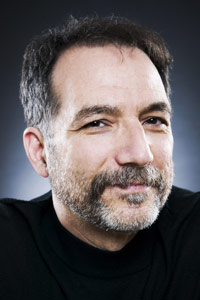 Steve AntoscaThankfully, Steve Antosca — director of the National Gallery of Art New Music Ensemble — was unfazed by the challenges, even turning them to his advantage in a spectacular, wonderfully provocative midday concert Wednesday.
Steve AntoscaThankfully, Steve Antosca — director of the National Gallery of Art New Music Ensemble — was unfazed by the challenges, even turning them to his advantage in a spectacular, wonderfully provocative midday concert Wednesday.
Wiring the Rotunda with a battery of speakers, Antosca transformed it into an immense temple of sound, presenting a program of theatrical new works that married humans with computers, and ancient myths with contemporary aesthetics. Temple bells were rung by drum-playing robots; a musician’s gestures were transformed, via computer, into a symphony of otherworldly sounds; and the birth of the world (no less) was enacted powerfully in sound. Not your ordinary day at the museum.
Virtually every work on the program pushed out the possibilities of human performance in intriguing ways. Musician Forrest Tobey, for instance, seemed to “play” the empty space around him by moving small batons (known as a Buchla Lightning wands) in a piece by Antosca called “echoic landscape”; each gesture was read by a computer and turned into sound, from disembodied bells to torrents of notes that swept around the room.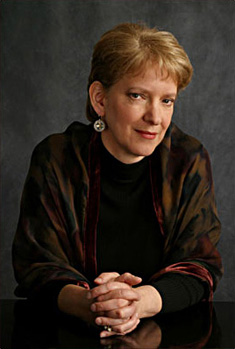 Judith Shatin“Penelope’s Song” by Judith Shatin took a yearning lament for saxophone and set it over a recorded track built from the sounds of a wooden loom, in a poignant work derived from the Ulysses myth. Saxophonist Noah Getz accompanied himself on an electronic track as he traced a path through the room in Antosca’s “in every way I remember you.” And in Shatin’s completely charming “Sic Transit,” six robots tapped away cheerfully at wood blocks and bells as they accompanied percussionist Ross Karre.
Judith Shatin“Penelope’s Song” by Judith Shatin took a yearning lament for saxophone and set it over a recorded track built from the sounds of a wooden loom, in a poignant work derived from the Ulysses myth. Saxophonist Noah Getz accompanied himself on an electronic track as he traced a path through the room in Antosca’s “in every way I remember you.” And in Shatin’s completely charming “Sic Transit,” six robots tapped away cheerfully at wood blocks and bells as they accompanied percussionist Ross Karre.
There was more; it was equally smile-inducing. And if you missed it, take heart: The program repeats Thursday at 12:10 p.m.
Antares Quartet at the Library of Congress
By Stephen Brookes • The Washington Post • March 13, 2011
Isn’t it great when the stand-in steals the show? That’s what happened Friday night at the Library of Congress after featured singer Marianna Mihai-Zoeter came down with a cold and was replaced at the last minute by the lyric soprano Hyunah Yu. Despite only one rehearsal with the Antares Quartet, Yu turned in a reading of Franz Schubert’s “Der Hirt auf dem Felsen” (“The Shepherd on the Rock”) that was absolutely captivating.Hyunah YuThat was no easy task: “Shepherd” is a longish, quasi-coherent lied that Schubert cobbled together as a showpiece for different dramatic styles, and it has all the emotional complexity of a Meissen figurine. But Yu (accompanied ably by Garrick Zoeter on clarinet and Eric Huebner on the piano) handled it with exceptional style and effortless lyrical grace. The audience, to judge by the general swooning, was helplessly in love by the end.
But the evening really belonged to Antares, an unusual ensemble of piano, clarinet, cello and violin that is making an impressive name for itself in contemporary music. Things got off to a roiling start with John Harbison’s 1988 “Fantasy Duo for Violin and Piano,” a work so scorchingly intense that it left burn marks on the ears. Don’t be misled by the “fantasy” title: This was a tightly argued work that built tentative gestures, brutal slashes of color, shimmering pastels and sweeping melodic lines into a heady, headlong rush of ideas. It was a dazzling piece, superbly played by violinist Jesse Mills.
Caroline Mallonee’s “Shadow Rings” might not have been the strongest work on the program, but it was arguably the most likable. There’s a refreshing, what-the-hell playfulness to Mallonee’s music, and “Shadow” was full of inventive ideas and sonic wonders; this is an imaginative young composer from whom we hope to hear more.
The evening closed with Olivier Messiaen’s iconic “Quatuor pour la Fin du Temps,” a work Antares has specialized in. The group’s reading was polished, meditative and almost serene — an interesting contrast to some of the more edgy and terrifying accounts heard here in recent years.

